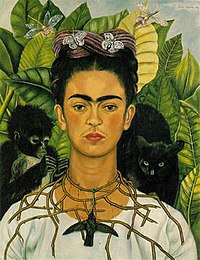Frida Kahlo
From Wikipedia, the free encyclopedia
| Frida Kahlo | |
|---|---|

Frida Kahlo, Self-portrait with Thorn Necklace and Hummingbird, Nikolas Muray Collection, Harry Ransom Center, University of Texas at Austin[1]
| |
| Birth name | Magdalena Carmen Frieda[2] Kahlo y Calderón |
| Born | July 6, 1907 Coyoacán, Mexico |
| Died | July 13, 1954 (aged 47) Coyoacán, Mexico |
| Nationality | Mexican |
| Field | Painting |
| Training | Self–taught |
| Movement | Surrealism, Magic Realism |
| Works | in museums:
|
Kahlo's life began and ended in Mexico City, in her home known as the Blue House. She gave her birth date as July 7, 1910, but her birth certificate shows July 6, 1907. Kahlo had allegedly wanted the year of her birth to coincide with the year of the beginning of the Mexican revolution so that her life would begin with the birth of modern Mexico. Her work has been celebrated in Mexico as emblematic of national and indigenous tradition, and by feminists for its uncompromising depiction of the female experience and form.[7]
Mexican culture and Amerindian cultural tradition are important in her work, which has been sometimes characterized as Naïve art or folk art.[8] Her work has also been described as "surrealist", and in 1938 André Breton, principal initiator of the surrealist movement, described Kahlo's art as a "ribbon around a bomb".[7]
Kahlo had a volatile marriage with the famous Mexican artist Diego Rivera. She suffered lifelong health problems. Many of her health problems were the result of a traffic accident she survived as a teenager. Recovering from her injuries isolated her from other people and this isolation influenced her works, many of which are self-portraits of one sort or another. Kahlo suggested, "I paint myself because I am so often alone and because I am the subject I know best."[9] She also stated, "I was born a bitch. I was born a painter."[10]
Contents
Childhood and family
Frida Kahlo was born on July 6, 1907, in the house of her parents known as La Casa Azul (The Blue House), in Coyoacán. At the time, Coyoacán was a small town on the outskirts of Mexico City.Kahlo's father, Guillermo Kahlo (1871–1941), was born Carl Wilhelm Kahlo in 1871, in Pforzheim, Germany, the son of Jakob Heinrich Kahlo and Henriette Kaufmann, who were Jewish. Carl Wilhelm Kahlo traveled to Mexico during 1891, at the age of nineteen, and upon his arrival, changed his German forename, Wilhelm, to its Spanish equivalent, Guillermo.[11][12]
Roman Catholic of mixed Amerindian and Spanish ancestry.[16] Frida's parents were married soon after the death of Guillermo's first wife, which occurred during the birth of her second child. Although their marriage was quite unhappy, Guillermo and Matilde had four daughters, with Frida being the third. She had two older half sisters who were raised in the same household. Frida remarked that she grew up in a world surrounded by females. However, during most of her life, Frida remained on amicable terms with her father.
The Mexican Revolution began during 1910, when Kahlo was three years old. Kahlo later claimed that she was born in 1910, allegedly so that people would associate her with the revolution. In her writings, she recalled that her mother would usher her and her sisters inside the house as gunfire echoed in the streets of her hometown.
Kahlo contracted polio at age six, which left her right leg thinner than the left, which she disguised later in life by wearing long, colorful skirts. It has been conjectured that she was born with spina bifida, a congenital condition that could have affected both spinal and leg development.[17] She participated in boxing and other sports. In 1922, Kahlo was enrolled in the Preparatoria, one of Mexico's premier schools, where she was one of only thirty-five girls. Kahlo joined a clique at the school and became enamored of the strongest personality of it, Alejandro Gómez Arias. During this period, Kahlo also witnessed violent armed struggles in the streets of Mexico City as the Mexican Revolution continued.
On September 17, 1925, Kahlo was riding in a bus that collided with a trolley car. She suffered serious injuries as a result of the accident, including a broken spinal column, a broken collarbone, broken ribs, a broken pelvis, eleven fractures in her right leg, a crushed and dislocated right foot, and a dislocated shoulder. Also, an iron handrail pierced her abdomen and her uterus, compromising her reproductive capacity.
The accident left her in a great deal of pain while she spent three months recovering in a full body cast. Although she recovered from her injuries and eventually regained her ability to walk, she had relapses of extreme pain for the remainder of her life. The pain was intense and often left her confined to a hospital or bedridden for months at a time. She had as many as thirty-five operations as a result of the accident, mainly on her back, her right leg, and her right foot. The injuries also prevented Kahlo from having a child because of the medical complications and permanent damage. Though she conceived three times, all her pregnancies had to be terminated.[18]








Nenhum comentário:
Postar um comentário